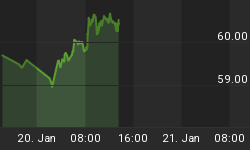There are two reasons why the price of gold has been under pressure in the last few days. One of them is legitimate; while the other is completely without grounds.
-
The U.S. Labor Department announced on Thursday that Initial Jobless Claims fell 30k for the week ending October 6th. The plunge took first-time claims for unemployment insurance to a four-year low. Despite the fact that this drop was mainly produced by one large state not properly reporting additional quarterly claims, the gold market took the data as a sign interest rates may soon have to rise. So I thought it would be a good time to explain that rising interest rates would not negatively affect the price of gold, as long as it is a market-based reaction to inflation; rather than the work of the central bank pushing rates positive in real terms.
The price of gold increased from $100 an ounce in 1976, to $850 an ounce by 1980. During that same time period the Ten year note yield increased from 7% to 12.5%. The reason why gold increased, despite the fact that nominal interest rates were rising, is because real interest rates were falling throughout that time frame. Bureau of Labor statistics shows that inflation as measured by the Consumer Price Index jumped from 6% in 1976 to 14% by early 1980. In addition, the Fed, under Arthur Burns and G. William Miller, kept the Funds rate far below inflation throughout their tenure; increasing the interbank lending rate from 5% in 1976, to just 10.5% by late '79--just before Chairman Volcker took the helm.
Bernanke knows that the job market isn't really improving anywhere close to the level that he believes would result in rising aggregate prices. Therefore, the gold market should not fear an increase in interest rates anytime soon stemming from better jobs data and the Fed. Any such increase in rates would merely be a reaction to an increase in the rate of inflation and not the result of the central bank. Thus, they would not be rising in real terms and pose no risk at all to the gold market. It is only when a central bank boosts interest rates above the rate of inflation that gold prices would start to retreat. And there just isn't any hint of that from any central bank on planet earth at this time.
Gold prices have also soared in the last dozen years from $250 in 2001, to $1,760 per ounce today. Just like they did during the 1970's, real interest rates are still falling and the central bank is keeping the funds rate well below inflation throughout this current period.
The important point here is investors in precious metals need to only be concerned with the direction of real interest rates. As long as the rate of inflation is rising faster than the increase in nominal yields, gold prices will remain in a bull market.
-
The second reason (and perhaps the only legitimate one) why gold prices are under pressure is because the looming Fiscal Cliff is almost upon us. The base case scenario at Pento Portfolio Strategies is that politicians of both parties will once again act in their own self interest, rather than that of the country, and avoid the drastic spending cuts contained in the Sequestration. A steep contraction in government spending would cause a serious recession to occur in the short term, but is absolutely essential for the long-term health of the country.
However, U.S. deficits have been habitually north of $1 trillion for the last four years. The Federal Reserve has already increased their balance sheet by trillions of dollars; and that money has been used by commercial banks to monetize government debts and increase the money supply. If we do indeed go over the fiscal cliff, annual deficits would be halved and gold prices are discounting the potential reduction in the growth rate of outstanding debt and the money supply.
Investors should ignore the "improvement" in jobs data and instead focus on the rapidly crumbling economic situation around the globe. However, fiscal austerity is deflationary in nature. If it is undertaken in the U.S., (even if by force) commodity prices and indeed most markets across the board would feel the pinch. It is still prudent to stay long precious metals, energy and agricultural commodities and their stocks at this juncture. However, purchasing some put protection on your investments may also be a prudent idea.
Respectfully,
















